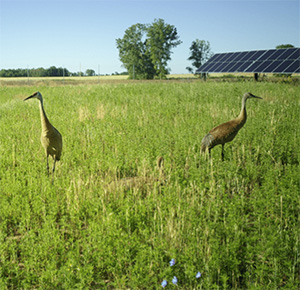
The impact of large-scale photovoltaic (PV) solar energy facilities on bird populations in the United States is unclear, as few studies have been conducted in regions outside of the Southwestern U.S. Understanding the nature and magnitude of avian mortality, for example, is crucial in determining the net effects of these facilities on bird populations. Despite concerns regarding avian mortality at PV sites in the Southwestern U.S., scientists do not fully understand the extent of this impacting factor in other regions that have never been monitored. Furthermore, there is growing information suggesting that properly sited and managed facilities could offer benefits to bird populations by providing habitat for foraging, nesting, and roosting, thereby offsetting some or all of the mortality risks.
To assess both the potential benefits and adverse impacts, Argonne National Laboratory (Argonne) and its collaborators are conducting a study on avian-solar interactions at large-scale PV solar energy facilities across the U.S.

The study integrates sensing technologies (cameras and acoustic sensors) and traditional field methods to collect data at PV facilities across multiple U.S. regions. Bird carcass searches by human observers (or human-dog teams) through post-construction monitoring (PCM) remains the most scientifically defensible approach to estimating avian mortality. However, its critical limitation is the inability to determine the causes of fatality for most carcass detections, such as how and why birds died. Integrating continuous video recordings and incidental photos into monitoring addresses this limitation. This combined approach will quantify avian mortality through PCM and identify causal mechanisms through the analysis of video and photographic data.
Additionally, acoustic recorders are used to quantify avian diversity. We will analyze these multiple data streams using machine-learning models, bird behavioral analyses (known as ethograms), and statistical analyses to quantify bird diversity, abundance, and behavior and characterize avian mortality rates at PV sites across the country, including in regions never studied before. We will compare the results to understand how avian mortality and associated causal mechanisms, behavior, diversity, and abundance at PV sites varies across geographic regions and seasons. More information on the sensor methods is provided in the link below. Collectively, we will analyze these data streams to address the following research questions:

This is a 3-year project funded by the U.S. Department of Energy Solar Energy Technologies Office.
Argonne is working closely with WEST, Texas State University, William & Mary, and Hampshire College to conduct field work and data analyses.
In addition, the project is being informed and guided by advisory groups made up solar industry representatives, scientific professionals, and members of federal and state natural resource agencies. The project team is thankful to all of these organizations for their participation and support of this project. See the Partners page for a list of all partner solar companies and advisory organizations.
Subscribe to our email list to receive updates about our project.